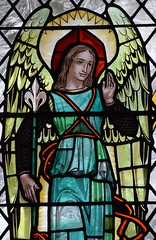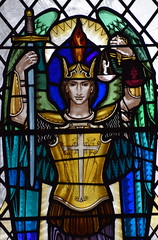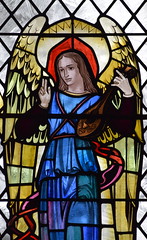| |
|
Suffolk
has no coast road, and this makes it different
and special. There is no ribbon of development,
and settlements near to the sea can feel remote
from each other. Indeed, is is often quicker to
travel by boat than to attempt to reach one from
another by road. Further inland, there is another
veil of protection, for here is the heathland,
and the forests with their millions of trees.
Among them are the abandoned American airbases of
Woodbridge and Bentwaters, and villages that hide
and huddle, sometimes surprisingly large places.
Tunstall is one of them.
The church sits on the back road towards Orford.
It has a grand tower, but it was struck by
lightning in the 18th century. The most recent
rebuilding of the top was in the 1970s,
presumably replacing the former job, which
Cautley thoroughly disparaged. There's a lovely
priest door in the south wall of the chancel. I
have a vivid memory of passing this way in the
late 1990s and finding it completely and
delightfully overgrown with comfrey. To the south
of the chancel is a gravestone which supposedly
commemorates two smugglers overcome by the fumes
of their wares.
The church is long and narrow, but the clear
windows, white walls and charming brick floors
mean that it is full of light, and are a perfect
setting for the creamy woodwork of a superb set
of box pews. The west end of the nave is open,
creating a sense of space around a prettily-set
Purbeck Marble font. On the side of the tower
arch, the graffiti includes several boats as they
might have been seen on the 17th Century River
Deben. The one jarring note in all this is the
wedding cake of a pulpit, and yet in a funny way
it is not out of place in all this light and
space.
The restraint of the nave offsets the beautiful
simplicity of the chancel, where the clean,
modern sanctuary is backed by a charming window
of the 1950s depicting three Archangels, St
Michael in the centre flanked by St Gabriel and
St Raphael. The maker's mark shows that it was
designed by Eric Dilworth, that the glazier was J
Andrews, and the painter Painter N Attwood - were
they working for the George King & Son
workshop of Norwich? The window suits this church
perfectly, being simple and beautiful   
The
war memorial, one of several in this part of
Suffolk designed by Munro Cautley, records how
many people lived in the parish at the start of
the war, how many men went off to fight, and how
many died. Most church war memorials should be
taken with a pinch of salt, as they often
recorded only the Anglicans of the parish, and
then only those of whom there was a record, or
who still had family in the parish once the
turmoil of war had ended. But these statistics
have a pleasing verisimilitude, and it is
sobering to reflect that, of the 625 residents of
Tunstall in 1914, no fewer than 131 of them went
off to fight - that's about half of all the men
in the parish. Eighteen of them never came back.
East of Tunstall, the countryside gets wilder,
and off in the direction of lonely Wantisden
there is a little hamlet, where you'll find the
Tunstall Baptist Church surrounded by a huddle of
cottages, as if the early 19th century
non-conformists of this parish had set themselves
adrift in a lifeboat. To the north, on the bank
of the river Alde, the parish contains one of
Suffolk's most famous buildings, Snape Maltings.
|
|
|

